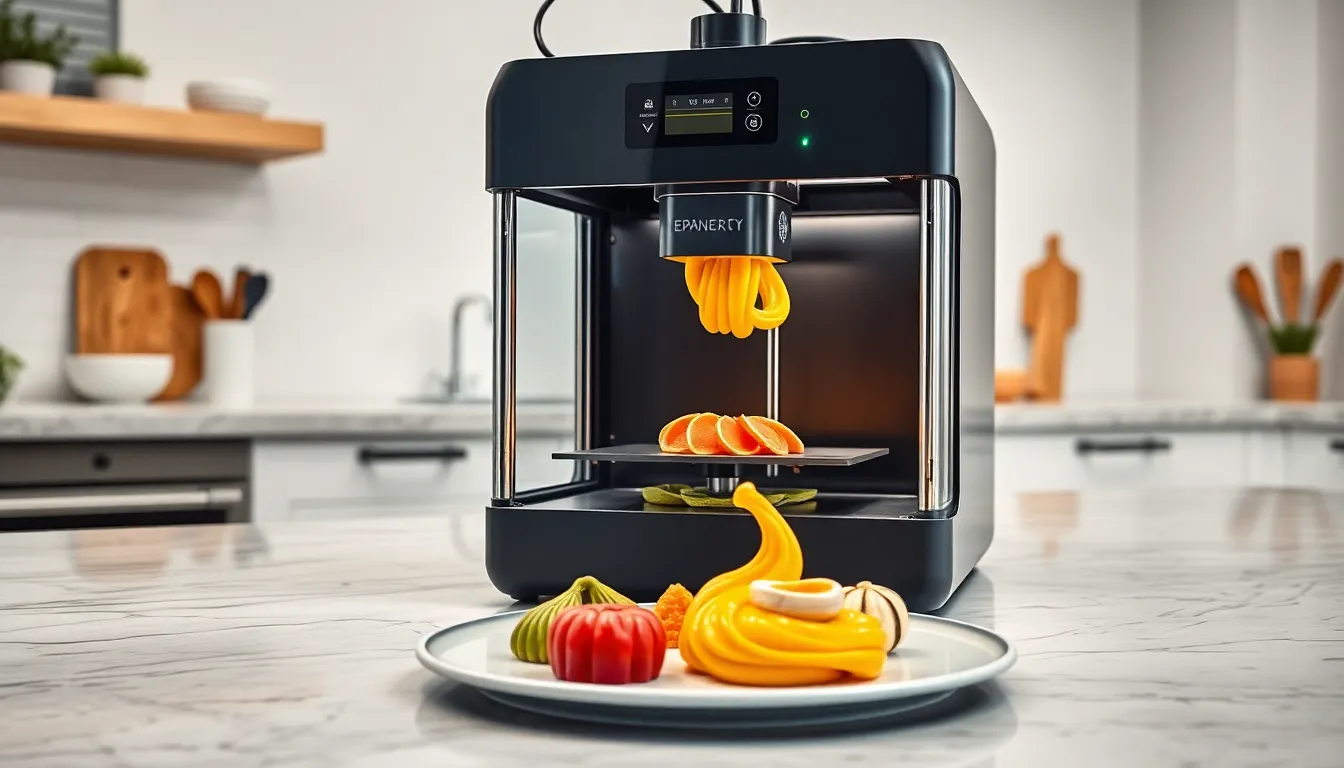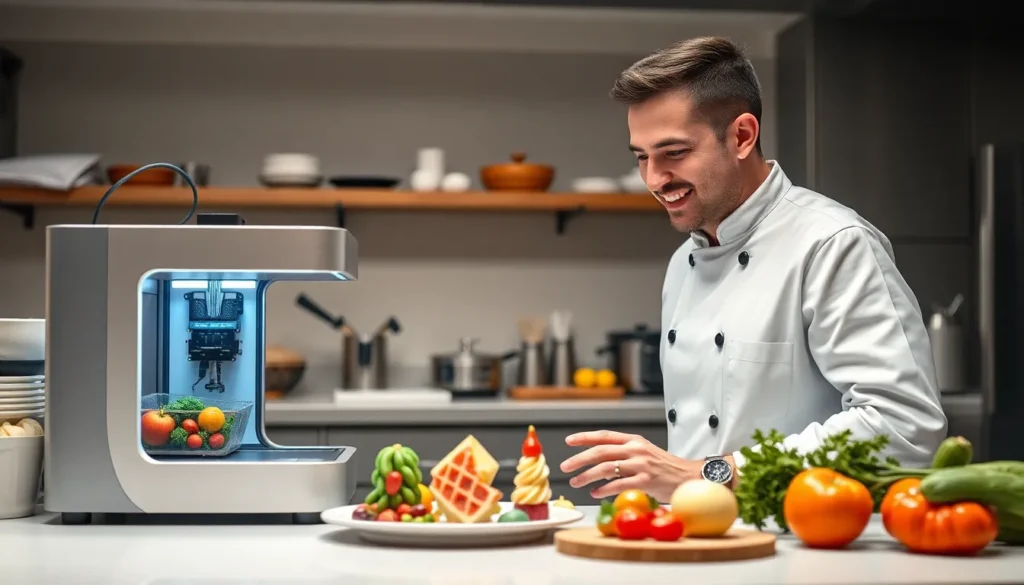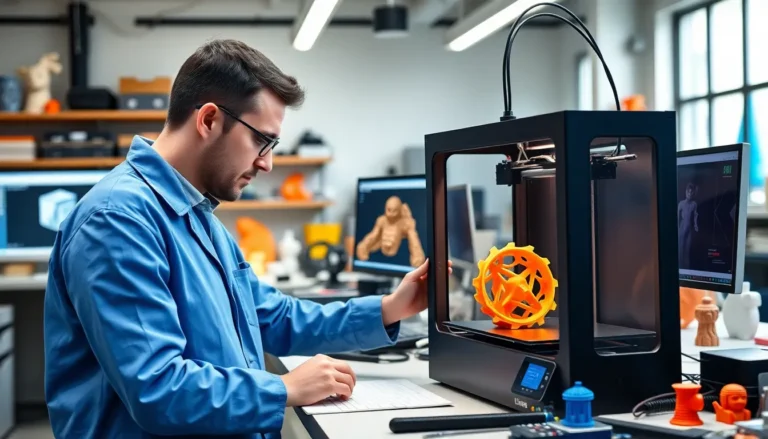Table of Contents
ToggleImagine biting into a burger that’s been crafted layer by layer by a printer instead of a chef. Sounds like something out of a sci-fi movie, right? Welcome to the world of 3D food printing, where culinary creativity meets cutting-edge technology. This innovative process is not just about novelty; it’s revolutionizing how we think about food, nutrition, and even sustainability.
With 3D food printing, chefs can design intricate dishes that are as visually stunning as they are delicious. It’s like playing with your food, but with a high-tech twist! From personalized nutrition to reducing food waste, this futuristic approach is reshaping the dining experience. So, buckle up as we dive into the deliciously quirky realm of 3D food printing and discover how it’s serving up a feast for the future.
What Is 3D Food Printing?
3D food printing combines technology and culinary art, revolutionizing how food is created and experienced. This process uses additive manufacturing techniques to construct edible items layer by layer. Ingredients, such as purees, doughs, and chocolates, are loaded into specialized cartridges and extruded through a nozzle according to a designed model.
Customization stands out as one of the most appealing aspects of 3D food printing. Chefs can design intricate shapes and structures that traditional cooking methods can’t achieve. Creating personalized dishes allows for unique textures and flavors, appealing to diverse consumer preferences.
Sustainability plays a significant role in this technology. By minimizing food waste, chefs can more efficiently utilize ingredients, transforming food preparation. 3D food printers can also help in producing meals from alternative proteins and plant-based ingredients, addressing dietary shifts towards healthier consumption patterns.
Precision and control enhance the cooking process. Technicians program the printer for exact measurements and parameters, ensuring consistent results. Additionally, intricate designs entice diners, making each meal not just food but a visually appealing work of art.
Adoption of 3D food printing has occurred in various sectors, including restaurants, catering, and home kitchens. Innovative chefs and food technologists are exploring new potential applications, driving the culinary industry forward. With the capacity to build meals from scratch, this technology encourages a new wave of creativity in modern gastronomy.
The Technology Behind 3D Food Printing

3D food printing utilizes innovative processes to revolutionize culinary experiences. This technology transforms how chefs and consumers approach meal preparation and presentation.
Materials Used in 3D Food Printing
Commonly used materials include purees, doughs, and chocolates. Each ingredient offers unique properties that enhance the 3D printing process. Specialized filaments made from alternative proteins and plant-based sources are gaining popularity due to their sustainability benefits. These materials allow for intricate designs while supporting healthier dietary choices. Some manufacturers also explore powders transformed into pastes, expanding the range of possible textures and flavors.
How 3D Food Printers Work
3D food printers operate through additive manufacturing techniques. They layer materials to create intricate food items according to digital models. The process begins with a computer-aided design file, which guides the printer. Ingredients flow through nozzles that extrude them precisely at defined temperatures, ensuring optimal consistency. After each layer is deposited, the printer moves to build on the previous one, forming complex shapes that traditional cooking methods cannot replicate. This method offers unmatched customization, allowing chefs to design dishes tailored to specific customer preferences.
Applications of 3D Food Printing
3D food printing offers unique applications in the culinary world, notably in customization and sustainability.
Customization and Personalization
Chefs leverage 3D food printing to create tailor-made dishes, allowing for specific textures and flavors. It enables adjustments based on dietary restrictions, preferences, or artistic vision. Unique designs, such as intricate shapes or personalized messages, cater to individual customer experiences. Restaurants utilize this technology for special events, enhancing celebrations with custom-built desserts. Customization enhances consumer engagement, as patrons participate in the creative process. Each printed element contributes to a memorable dining experience, pushing culinary boundaries further.
Sustainability Benefits
Sustainability plays a crucial role in 3D food printing applications, significantly reducing food waste. The precision of this technology allows for accurate portion management, minimizing leftovers. Alternative proteins and plant-based ingredients are often used in the printing process, supporting more sustainable diets. Chefs utilize 3D food printing for better resource efficiency, utilizing ingredients that may otherwise go unused. The shift towards environmentally friendly practices aligns with rising consumer demand for sustainable food options. Overall, this technology not only improves resource management but also promotes healthier eating habits.
Challenges in 3D Food Printing
3D food printing, despite its advancements, faces notable challenges that hinder widespread implementation.
Technical Limitations
Technical limitations impact design flexibility and ingredient compatibility. Certain materials don’t extrude smoothly, causing inconsistency in shapes and textures. Equipment can be expensive and requires specialized knowledge for operation. Many printers lack the ability to work with multiple ingredients simultaneously, which restricts culinary creativity. Additionally, achieving the precise temperatures for various food types poses difficulties. Results may vary between home kitchens and commercial settings, leading to a gap in user experience.
Market Acceptance
Market acceptance of 3D food printing remains cautious despite its potential. Various customers exhibit skepticism about the nutritional value and safety of 3D-printed foods. Many chefs appreciate the creativity but hesitate to adopt new technologies, fearing potential risks or equipment costs. Consumer education plays a crucial role in addressing these concerns, as awareness of the technology’s benefits can influence acceptance. Additionally, regulatory challenges complicate market introduction, creating barriers for manufacturers and chefs exploring this innovative approach.
Future of 3D Food Printing
Innovations in 3D food printing are poised to reshape culinary practices. Significant advancements in technology lead to the development of more efficient printers with enhanced precision. Rising interest among chefs and consumers fuels demand for personalized dining experiences.
Incorporation of alternative proteins into formulations enhances sustainability and addresses dietary needs. New materials, including plant-based filaments, support diverse culinary applications. Increased emphasis on nutrition encourages creative, health-oriented recipes that cater to various diets.
Adoption rates are growing as restaurateurs recognize the potential of 3D printing in optimizing kitchen operations. Chefs increasingly embrace this technology for its ability to create visually striking dishes. Customized meal solutions emerge as a key offering, promising to meet specific tastes and dietary restrictions.
As the market expands, educational initiatives will address consumer skepticism surrounding safety and nutrition. Collaboration among industry stakeholders will drive regulatory developments aimed at ensuring food safety standards. Technological solutions targeting ingredient compatibility will overcome existing limitations related to 3D printing.
The future of 3D food printing promises to transform the food landscape significantly. Continued innovations will likely enhance both culinary creativity and sustainability efforts. Moreover, increased consumer engagement through tailored dining experiences speaks to the inevitable evolution of gastronomy.
3D food printing stands at the forefront of culinary innovation. It merges technology with artistry to create personalized dining experiences while addressing pressing issues like sustainability and food waste. As chefs and consumers become more engaged with this technology, the potential for unique flavors and intricate designs continues to expand.
The future looks promising as advancements in 3D food printing technologies evolve. With a focus on alternative ingredients and improved equipment, the culinary landscape is set for transformation. By overcoming current challenges and fostering consumer education, this revolutionary approach to food preparation will likely redefine how meals are created and enjoyed.





